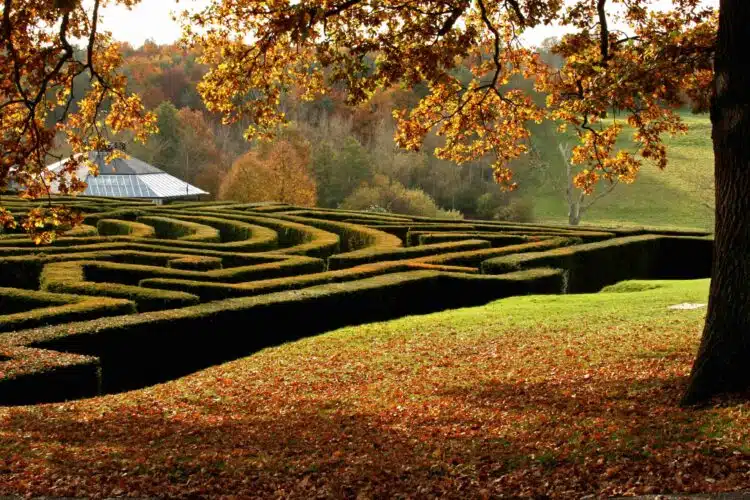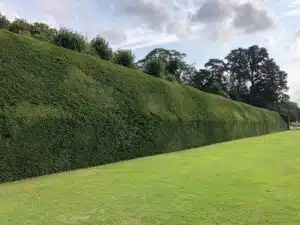HALF PRICE SALE ON EVERYTHING ENDS TONIGHT
NEW SEASON BARE ROOTS AT 50% OFF LAST SEASONS PRICES – ENDS 31 JULY
***TODAY ONLY – GET AN EXTRA 10% OFF SALE PRICES WITH CODE FLASH10***
Menu
HALF PRICE SALE ON EVERYTHING ENDS TONIGHT
NEW SEASON BARE ROOTS AT 50% OFF LAST SEASONS PRICES – ENDS 31 JULY
***TODAY ONLY – GET AN EXTRA 10% OFF SALE PRICES WITH CODE FLASH10***
 https://www.hopesgrovenurseries.co.uk/wp-content/uploads/2024/02/yew-english-2-750x500.jpg
https://www.hopesgrovenurseries.co.uk/wp-content/uploads/2024/02/yew-english-2-750x500.jpg
Regrets, I’ve had a few. But then again, too few to mention. Yes, just like Frank Sinatra, I’ve done it my way, but in Val-Bourne style. And that’s why I love to garden, it’s one of the things in life that still allow personal freedom in a world dominated by restrictions and regulations. I can still do what I want in my own patch, well more or less!
However, I do regret one thing Frank. I have never planted a yew hedge, because I listened to worthy garden writers and they all emphasised how slow growing yew is. By the time I’d learnt the truth, ie, you can get a yew hedge in ten years, I’d moved to my present garden perched on top of The Cotswolds. It’s surrounded by low stone walls, because the views are amazing. With it comes the wind and rain but, if I planted hedges of any kind the sunsets and the fields would disappear.
My chance has gone, for I won’t be moving! I will never create a comforting all-green screen for bright-white plants and recreate the classy feel of The White Garden at Sissinghurst. If I use white in my garden, it glares at me like a sulky teenager denied another packet of crisps just before bedtime. White is the most difficult colour in the garden, especially seen under the sort of bright light we get on top of the scarp. I’m still reeling from the memory, or should that be nightmare, of a whole bed of Rosa ‘Mme Hardy’, a double white with a green button eye. Lovely in shade, but positively evil in the glare of full sun! Similarly, the rambling ‘Sander’s White’ also needs a touch of shade. This useful rose comes late to the rose-garden party, opening in July rather than June.
Being slow-growing is not the only misconception about yew, it turns out. Many of the ancient yews we thought were thousands of years old, are in fact much younger. The yew tree in my own village church in Gloucestershire was thought to be 600 years old, for instance. Another, at Much Marcle in Herefordshire, is said to be even older. It’s one of 70 ancient trees across the country, which were dedicated to Her Majesty in celebration of her Platinum Jubilee. It’s the only tree in Herefordshire to be included in this very special list. People come from miles around to sit on the seat inside Much Marcle’s hollow veteran yew.
Dendrologists have been estimating the age of older trees, by measuring the girth of the trunk to assess their age. There’s are formulae, but White’s formula is the most common apparently. White assumed that, after a period of rapid growth, the tree slowed down. That sounds a little like me. And, can I say, that I’m only too glad that my personal girth is not being measured at the moment, after the Christmas ‘eatathon’. It has taken a toll on my waistline. Anyway, the wider the trunk, the older the tree. You get the gist
Look at lots of large trees and you may find a nail about a metre off the ground and this is the standard position for measuring the girth. I only know this because our village is used as a location for Father Brown. I went to watch the filming and spoke to the lovely Mark Williams. I even got him to sign my Father Brown tea towel. I’m such a groupie.
Mark Williams asked me about the age of the huge sycamore on our village green and I confessed that I had no idea, despite walking past most days. He told me that lots of nearby villages also have huge sycamores. That evening the Best Beloved and I did a village recce and found that every sycamore tree, including the one on our green, had a nail a metre off the ground. Someone was measuring them!
Measuring the girth and using it to assess the age can be incredibly inaccurate, because it depends on the species, on whether it’s getting a lot of light, on the geology. This means that the size of trees planted at the same time, around the same location, can vary enormously. I know all about conditions, because anything I plant in my cold garden sits still for a season or two. If I was warmer, it would romp away,
Tree rings vary from year to year, according to the conditions. In good growing years the gaps between the rings are wide and generous. After a poor season, the gap is narrow and it can be almost invisible. Scientists from Brunel University have been looking at several other methods, including core samples. You can read more about their discoveries on their website, under Scientists poke a hole in the age of trees which was posted on 14th August 2019.
Doctor Andy Moir of Brunel University carried out a series of new studies using alternative techniques – such as taking a core from the tree and measuring the rings. They demonstrated that using girth measurements can drastically overestimate the age of a tree, suggesting that many of Britain’s oldest trees are likely to be much younger than previously reported.
Britain’s oldest yew trees, once estimated to be thousands of years old, are all under 2000 years or less. Old yew trees, previously declared as 5000 years old using a derivative of White’s formula, were calculated to be only 950 years old when their rings were measured. As I understand it, conditions dictated growth and not age.
This has upset the notion that the yew trees are older than the religious buildings they are found close to. Further evidence was gathered from newly planted yew hedges and specimens at Kew Gardens and at Hampton Court and they were used as reference points. The fact that they’re in the south of England, close to River Thames and in built-up areas meant that they grew well. They’d be slower off the mark here, but it would still be possible to get a hedge in 12 years.
Hedges are planted to provide privacy and shelter, but there are definite benefits to choosing yew, because it only needs a once-a-year trim, preferably between August and November if possible. Faster growing hedges need cutting more often. The biggest benefit of yew is its ability to grow back from bare wood. It is the only conifer able to do this. Veteran yew hedges should be tackled in stages. Cut one side back at a time.

Nor surprisingly, the yew tree is shrouded in myth and magic. They are seen as guardians, standing sentinel over many graveyards, because their foliage is poisonous the grazing animals. I have seen sheep grazing churchyards though and perhaps they were grazed before the age of the mower.
Some of the best yews are in churchyards and legend has it that there are 99 fastigiate yews in Painswick’s churchyard in Gloucestershire. It was always said, that if a hundredth were planted the devil would destroy it. The church was faced with a bit of a dilemma in 2000 when every parish in the Diocese of Gloucester was given a yew tree to plant to mark the millennium. Painswick took up the challenge and it’s evaded the devil so far, although it is planted on the north side of the church. In 2007, one of the Painswick yews was felled by a flood, but it’s coming back from the base – evil or not.
Some yews mark boundaries and some, like those on the neolithic barrow at Ashbrittle in Somerset, hint that the yew was sacred long before Christianity arrived. One thing’s for sure, should you plant a yew hedge – your yew will definitely outlive you!
Many of our customers buy topiary plants (and hedging plants) to grow in containers, one frequently asked question is how large does the pot that I plant them into need to be?
Expert horticultural advice on the merits and pitfalls of planting bare root yews, and how to get the best from them.
Pleached trees are a garden-design favourite, because they provide an instant leafy screen that looks stylish as soon as it’s planted. They offer privacy for you and they help to muffle noise and that’s becoming more important in our busy world. They provide a living screen that’s far more eco-friendly than a stark wooden fence…